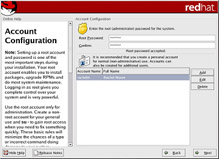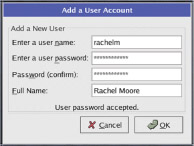Account Configuration
|
The Account Configuration screen allows you to set your root password. Additionally, you can set up user accounts for you to log in to once the installation is complete.

Figure 2-23. Account Creation
Setting the Root Password
Setting up a root account and password is one of the most important steps during your installation. The root account (sometimes called the superuser) is similar to the administrator account used on Windows NT machines. The root account is used to install packages, upgrade RPMs, and perform most system maintenance. Logging in as root gives you complete control over your system.
| Warning | Because the root user has complete access to the entire system, logging in as the root user is best done only to perform system maintenance or administration. The root account does not operate within the restrictions placed on normal user accounts, so changes made as root can have implications for your entire system. Following this important rule will minimize the chances of a typo or an incorrect command damaging your system. |
| Warning | To become root when logged into another account, for instance if you need to fix something quickly, you can type su - at the shell prompt in a terminal window and then press Enter; then enter the root password and press Enter. |
The installation program will prompt you to set a root password2 for your system. A root password is the administrative password for your Red Hat Linux system. You must enter a root password; the installation program will not let you proceed to the next section without entering a root password.
The root password must be at least six characters long; the password you type is not echoed to the screen. You must enter the password twice; if the two passwords do not match, the installation program will ask you to enter them again.
You should make the root password something you can remember, but not something that is easy for someone else to guess. Your name, your phone number, qwerty, password, root, 123456, and anteater are all examples of bad passwords. Good passwords mix numerals with upper and lower case letters and do not contain dictionary words: Aard387vark or 420BMttNT, for example. Remember that the password is case-sensitive. It is recommended that you do not write down this or any password you create; if you do write down your password, keep it in a secure place.
| Caution | Do not use one of the example passwords offered in this book. Using one of these passwords could be considered a security risk. |
| Tip | To change your root password after you have completed the installation, use the Root Password Tool. Type the redhat-config-rootpassword command in a shell prompt to launch the Root Password Tool. If you are not logged in as root, it will prompt you for the root password to continue. |
Setting Up User Accounts
If you choose to create a user account now, you will have an account to log in to once the installation has completed. This allows you to safely and easily log into your computer without having to be root to create your user account.

Figure 2-24. Creating a User Account
Click the Add button to add a new, non-root, user. Enter a user name for the user account. Next, enter and confirm a password for that user account. Enter the full name of the account user and click OK. Your account information will be added to the account list. You can also Edit or Delete the user accounts you have created and no longer want.
| Tip | To change your user account configuration after you have completed the installation, click the Main Menu button and choose System Tools > User Manager (or, at the command prompt, enter the redhat-config-users command) to launch the User Manager. If you are not logged in as root, your system will prompt you for the root password to continue. |
|
EAN: N/A
Pages: 223